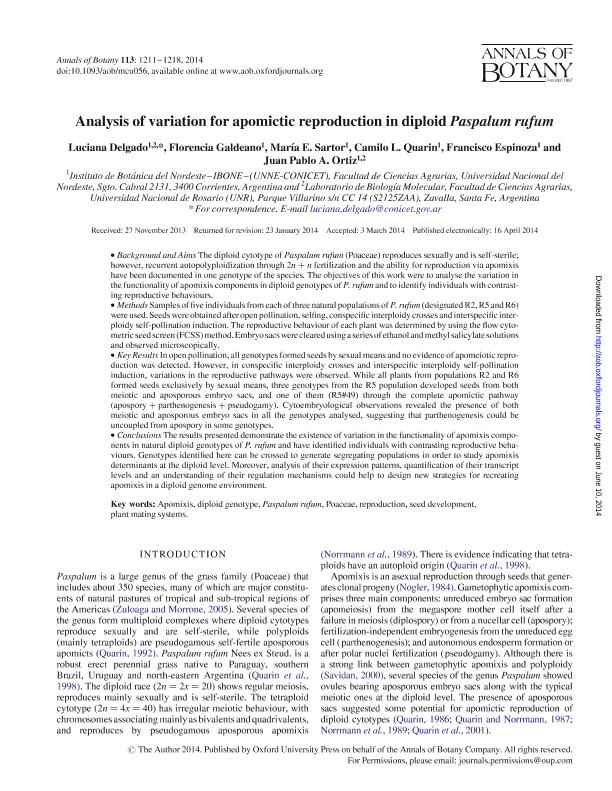Mostrar el registro sencillo del ítem
dc.contributor.author
Delgado Benarroch, Luciana

dc.contributor.author
Galdeano, Florencia

dc.contributor.author
Sartor, Maria Esperanza

dc.contributor.author
Quarin, Camilo Luis

dc.contributor.author
Espinoza, Francisco

dc.contributor.author
Ortiz, Juan Pablo Amelio

dc.date.available
2016-06-16T13:51:57Z
dc.date.issued
2014-06
dc.identifier.citation
Delgado Benarroch, Luciana; Galdeano, Florencia; Sartor, Maria Esperanza; Quarin, Camilo Luis; Espinoza, Francisco; et al.; Analysis of variation for apomictic reproduction in diploid Paspalum rufum; Oxford University Press; Annals of Botany; 113; 7; 6-2014; 1211-1218
dc.identifier.issn
0305-7364
dc.identifier.uri
http://hdl.handle.net/11336/6221
dc.description.abstract
Background and Aims: The diploid cytotype of Paspalum rufum (Poaceae) reproduces sexually and is self-sterile; however, recurrent autopolyploidization through 2n + n fertilization and the ability for reproduction via apomixis have been documented in one genotype of the species. The objectives of this work were to analyse the variation in the functionality of apomixis components in diploid genotypes of P. rufum and to identify individuals with contrasting reproductive behaviours. Methods: Samples of five individuals from each of three natural populations of P. rufum (designated R2, R5 and R6) were used. Seeds were obtained after open pollination, selfing, conspecific interploidy crosses and interspecific interploidy self-pollination induction. The reproductive behaviour of each plant was determined by using the flow cytometric seed screen (FCSS) method. Embryo sacs were cleared using a series of ethanol and methyl salicylate solutions and observed microscopically. Key Results: In open pollination, all genotypes formed seeds by sexual means and no evidence of apomeiotic reproduction was detected. However, in conspecific interploidy crosses and interspecific interploidy self-pollination induction, variations in the reproductive pathways were observed. While all plants from populations R2 and R6 formed seeds exclusively by sexual means, three genotypes from the R5 population developed seeds from both meiotic and aposporous embryo sacs, and one of them (R5#49) through the complete apomictic pathway (apospory + parthenogenesis + pseudogamy). Cytoembryological observations revealed the presence of both meiotic and aposporous embryo sacs in all the genotypes analysed, suggesting that parthenogenesis could be uncoupled from apospory in some genotypes. Conclusions: The results presented demonstrate the existence of variation in the functionality of apomixis components in natural diploid genotypes of P. rufum and have identified individuals with contrasting reproductive behaviours. Genotypes identified here can be crossed to generate segregating populations in order to study apomixis determinants at the diploid level. Moreover, analysis of their expression patterns, quantification of their transcript levels and an understanding of their regulation mechanisms could help to design new strategies for recreating apomixis in a diploid genome environment.
dc.format
application/pdf
dc.language.iso
eng
dc.publisher
Oxford University Press

dc.rights
info:eu-repo/semantics/openAccess
dc.rights.uri
https://creativecommons.org/licenses/by-nc-sa/2.5/ar/
dc.subject
Apomixis
dc.subject
Diploid Genotype
dc.subject
Paspalum Rufum
dc.subject
Poaceae
dc.subject
Reproduction
dc.subject
Seed Development
dc.subject
Plant Mating Systems
dc.subject.classification
Ciencias de las Plantas, Botánica

dc.subject.classification
Ciencias Biológicas

dc.subject.classification
CIENCIAS NATURALES Y EXACTAS

dc.subject.classification
Agronomía, reproducción y protección de plantas

dc.subject.classification
Agricultura, Silvicultura y Pesca

dc.subject.classification
CIENCIAS AGRÍCOLAS

dc.title
Analysis of variation for apomictic reproduction in diploid Paspalum rufum
dc.type
info:eu-repo/semantics/article
dc.type
info:ar-repo/semantics/artículo
dc.type
info:eu-repo/semantics/publishedVersion
dc.date.updated
2016-01-05T16:31:50Z
dc.identifier.eissn
1095-8290
dc.journal.volume
113
dc.journal.number
7
dc.journal.pagination
1211-1218
dc.journal.pais
Reino Unido

dc.journal.ciudad
Oxford
dc.description.fil
Fil: Delgado Benarroch, Luciana. Consejo Nacional de Investigaciones Científicas y Técnicas. Centro Científico Tecnológico Nordeste. Instituto de Botánica del Nordeste (i); Argentina. Universidad Nacional de Rosario. Facultad de Ciencias Agrarias. Laboratorio de Biología Molecular; Argentina
dc.description.fil
Fil: Galdeano, Florencia. Consejo Nacional de Investigaciones Científicas y Técnicas. Centro Científico Tecnológico Nordeste. Instituto de Botánica del Nordeste (i); Argentina
dc.description.fil
Fil: Sartor, Maria Esperanza. Consejo Nacional de Investigaciones Científicas y Técnicas. Centro Científico Tecnológico Nordeste. Instituto de Botánica del Nordeste (i); Argentina
dc.description.fil
Fil: Quarin, Camilo Luis. Consejo Nacional de Investigaciones Científicas y Técnicas. Centro Científico Tecnológico Nordeste. Instituto de Botánica del Nordeste (i); Argentina
dc.description.fil
Fil: Espinoza, Francisco. Consejo Nacional de Investigaciones Científicas y Técnicas. Centro Científico Tecnológico Nordeste. Instituto de Botánica del Nordeste (i); Argentina
dc.description.fil
Fil: Ortiz, Juan Pablo Amelio. Universidad Nacional de Rosario. Facultad de Ciencias Agrarias. Laboratorio de Biología Molecular; Argentina. Consejo Nacional de Investigaciones Científicas y Técnicas. Centro Científico Tecnológico Nordeste. Instituto de Botánica del Nordeste (i); Argentina
dc.journal.title
Annals of Botany

dc.relation.alternativeid
info:eu-repo/semantics/altIdentifier/doi/10.1093/aob/mcu056
dc.relation.alternativeid
info:eu-repo/semantics/altIdentifier/doi/http://dx.doi.org/10.1093/aob/mcu056
dc.relation.alternativeid
info:eu-repo/semantics/altIdentifier/url/http://aob.oxfordjournals.org/content/113/7/1211
dc.relation.alternativeid
info:eu-repo/semantics/altIdentifier/url/http://www.ncbi.nlm.nih.gov/pmc/articles/PMC4030816/
dc.relation.alternativeid
info:eu-repo/semantics/altIdentifier/pmid/PMC4030816
Archivos asociados
